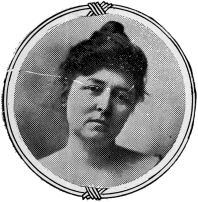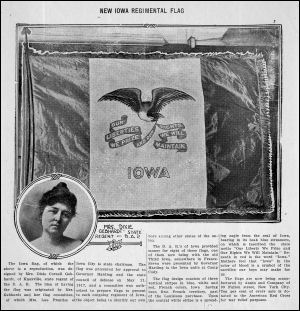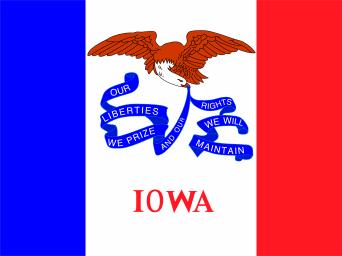The Iowa State Flag
George Earlie Shankle, Ph.D. explains the origin of the the Iowa State flag, in his 1938 revised edition
of State Names, Flags, Seals, Songs, Birds, Flowers and Other Symbols this way:
When the United States entered the World War, Iowa had no state flag. "It was expected that the Iowa men would fight in
State regiments as they had in former wars and this emphasized the desirability of a State flag to designate the Iowa
units. The organization most interested in this matter was the Iowa Society of the Daughters of the American Revolution
which had already prepared two designs. On May 11, 1917, Mrs. Lue B. Prentiss, chairman of the Society's flag committee,
Mrs. Dixie Gephardt, and a number of other interested persons appeared before the State Council on National Defense,
presented a flag design submitted by Mrs. Gebhardt, and asked that it be adopted as the State flag for use by the Iowa
soldiers. The Council approved the plan without much discussion. Thereupon the Daughters of the American Revolution had
a number of flags manufactured and presented one to each of the Iowa National Guard regiments, one of which — as the
168th United States Infantry — was already in France. The use of state flags however, was soon rendered almost
impossible by the policy adopted by the War Department of assigning men to military units without regard to the State from
which they came." 1
Iowa was admitted as a State of the Union on December 28, 1846.
A few years later, after graduating from the Geneva Medical College of New York, Dr. Norman R. Cornell
made his way to Marion County, Iowa. When the Twenty-third Iowa Infantry was organized for service in the Civil War,
Doctor Cornell was appointed an assistant surgeon. A few months later, he was appointed surgeon of the Fortieth Iowa
Infantry. During the last year of his service he served as a brigade surgeon. When the Civil War ended, Dr. Cornell
returned to Iowa to continue in general practice. He also became a specialist in diseases of the eye and the ear.
 |
Dixie Cornell Gebhardt
Courtesy: U.S. Library of Congress |
A daughter, Dixie, was born to Dr. Cornell on November 16, 1866 in Knoxville, Iowa.
In June 1900, at the age of 33, Dixie married George Tullis Gebhardt also of Knoxville.
The Spanish American War and the Philippine Insurrection (1898-1901) passed and the Great War (World War
I) began in Europe (1914).
Dixie Cornell Gebhardt had become a member of the Abigail Adams Chapter of the Society of the Daughters of
the American Revolution (D.A.R.) of Des Moines and served as State Recording Secretary from 1913 to 1916. In 1917, serving
as the State Organizing Regent, she helped organize the Mary Marion Chapter of the D.A.R. in Knoxville.
Meanwhile, in 1916, President Woodrow Wilson mobilized the National Guard to preserve order along the
Mexican border and, if possible, capture Pancho Villa, who had been raiding inside of U.S. territory.
In 1917, the United States was drawn into World War I.
Iowa was never in a hurry to adopt a state flag as Iowans felt, after the Civil war, that the stars and
stripes appropriately represented all of the United States. And so it was not until 1921, almost seventy-five years after
the admission of Iowa into the Union, that a state flag was finally adopted by the Legislature.
Like many State flags, the Iowa flag began life as a regimental banner for State National Guardsman.
The impetus for adoption of the banner originated with Iowa National Guardsmen stationed along the
Mexican border during World War I. The Guardsmen saw that units from other states carried identifying banners and the
Iowans felt that they should possess a unique banner of to identify their origins. When Governor William L. Harding was made
aware of this, he ordered that a banner be sent immediately to the Guardsmen, but soon found that Iowa did not have a State
banner.
The Iowa Society of the Daughters of the American Revolution (D.A.R.) and its flag committee, headed by
Mrs. Lue Prentiss of Knoxville, came to the rescue.
A design contest of sorts was held by the D.A.R. flag committee and in May, 1917 several design proposals, including
at least two by members of the D.A.R., were offered to Governor William L. Harding and the State Council on National Defense
by Mrs. Dixie Cornell Gebhardt, Organizing Regent of the Mary Marion Chapter D.A.R. in Knoxville, Mrs. Lue Prentiss, and others.
 |
| Courtesy: United States Library of Congress |
The flag design selected by Governor Harding and the State Council on Defense on May 11, 1917, was a
design by Mrs. Gebhardt.
Mrs. Gebhardt wrote that "Iowa's banner should embrace the history of its domain from the time of its
occupation by the Indians to discovery by the French and purchase from Napoleon by Jefferson, to its admission into the
Union, down to the present time. All this should be represented in a design so simple that school children and adults can
recognize its symbolism and know that it meant Iowa."2 The colors offered other significance as
well. White was chosen to symbolize the unwritten page of history at the state's beginning, when the first Native Americans
lived on Iowa's prairies and represents purity. Blue represents loyalty, justice, and truth and red stands for courage.
An eagle is displayed on the white center stripe of the flag. The eagle carries in its beak blue
streamers with the state motto, "Our liberties we prize, and our rights we will
maintain", inscribed on it in white letters. The State name "IOWA" is printed in red letters below the eagle. "Mothers
feel that "Iowa" in the color of blood is a symbol of sacrifice our boys may make for us."2
After the selection was made, another committee was organized to prepare flags to present to each
outgoing regiment of Iowa as well as those already in the field. The D.A.R. provided the funding for eight of these flags.
One was sent to the "old Third Iowa, somewhere in France. Seven were presented by Governor Harding to the Iowa Units at
Camp Cody."2
Early flags were manufactured by Annin and Company of New York City. Ten percent of every sale was
donated to the American Red Cross for war relief purposes.
The Iowa Regimental Flag was adopted by the Iowa General Assembly as the State flag on March 29, 1921.
Iowa's Centennial was marked in 1946. On December 28 of that year, a three-cent stamp depicting the Iowa State
Flag was issued, along with a first-day commemorative envelope with a picture of Gebhardt holding the original flag. The flag was
also incorporated as part of the design for the Iowa State Centennial Seal.
The 75th anniversary of the adoption of the Iowa State flag was celebrated on March 29, 1996. A monument
to honor the flag and Dixie Cornell Gebhardt was erected at 217 South Second Street in Knoxville. It was determined by the
Iowa Sesquicentennial Commission that the site was the home of Gebhardt when she designed the State flag.
Gebhardt died on October 16, 1955, in Knoxville, and is interred at Graceland Cemetery.
The original flag design, in crayon, is on display in the Marion County courthouse.
The city of Knoxville, County Seat of Marion County, calls
itself the "Birthplace of the Iowa Flag."
1. The Palimpsest, edited by John Ely Briggs (Published monthly at Iowa City by the state Historical Society of Iowa) October, 1924, vol. 5, p. 396-7.
2. New Iowa Regimental Flag, printed 1918, United States Library of Congress.
Iowa Flag Law
The following information was excerpted from The Iowa Code, Title 1, Subtitle, 1, Chapter
1B.
TITLE I. STATE SOVEREIGNTY AND MANAGEMENT.
SUBTITLE 1. SOVEREIGNTY.
CHAPTER 1B. STATE FLAG.
1B.1 Specifications of state flag.
The banner designed by the Iowa society of the Daughters of the American Revolution and presented to the state is hereby adopted as the state flag for use on all occasions where a state flag may be fittingly displayed. The design consists of three vertical stripes of blue, white, and red, the blue stripe being nearest the staff and the white stripe* being in the center. On the central white stripe is depicted a spreading eagle bearing in its beak blue streamers on which is inscribed the state motto, "Our liberties we prize and our rights we will maintain" in white letters, with the word "Iowa" in red letters below the streamers.
[C24, 27, 31, 35, 39, § 468; C46, 50, 54, 58, 62, 66, 71, 73, 75, 77, 79, 81, §31.1]
C93, §1B.1
95 Acts, ch 1, §1
*Editor's Note: On the original design, the white stripe was about equal to the sum of the others
1B.2 Use of state flag.
The design shall be used as the state flag and may be displayed on all proper occasions where the state is officially represented, either at home or abroad, or wherever it may be proper to distinguish the citizens of Iowa from the citizens of other states. When displayed with the national emblem, the state flag shall in all cases be subservient to and placed beneath the stars and stripes.
[C24, 27, 31, 35, 39, § 469; C46, 50, 54, 58, 62, 66, 71, 73, 75, 77, 79, 81, §31.2]
C93, §1B.2
95 Acts, ch 1, §2
1B.3 Flags on public buildings.
It shall be the duty of any board of public officers charged with providing supplies for a public building in the state to provide a suitable state flag and it shall be the duty of the custodian of that public building to raise the flags of the United States of America and the state of Iowa, upon each secular day when weather conditions are favorable.
[S13, §2804-c; C24, 27, 31, 35, 39, § 470; C46, 50, 54, 58, 62, 66, 71, 73, 75, 77, 79, 81, §31.3]
C93, §1B.3
95 Acts, ch 1, §3
Display of flags on school sites, see § 280.5
The following information was excerpted from The Iowa Code, Title 1, Subtitle, 1, Chapter
1C.
TITLE I. STATE SOVEREIGNTY AND MANAGEMENT.
SUBTITLE 1. SOVEREIGNTY.
CHAPTER 1C. PUBLIC HOLIDAYS AND RECOGNITION DAYS.
1C.11 Iowa State Flag Day.
The governor of this state is hereby requested and authorized to issue annually a proclamation designating the twenty-ninth day of March as "Iowa State Flag Day" and to urge that schools, civic organizations, governmental departments, and all citizens and groups display the Iowa state flag on that day and to reflect on and consider the heritage of the state flag.
98 Acts, ch 1023, §1
The following information was excerpted from The Iowa Code, Title 7, Subtitle 6, Chapter
280.
TITLE VII. EDUCATION AND CULTURAL AFFAIRS.
SUBTITLE 6. SCHOOL DISTRICTS.
CHAPTER 280. UNIFORM SCHOOL REQUIREMENTS.
280.5 Display of United States flag and Iowa state flag.
The board of directors of each public school district and the authorities in charge of each nonpublic school shall provide and maintain a suitable flagstaff on each school site under its control, and the United States flag and the Iowa state flag shall be raised on all school days when weather conditions are suitable.
[S13, §2804-a, -b; C24, 27, 31, 35, 39, § 4253; C46, 50, 54, 58, 62, 66, 71, 73, §280.4; C75, 77, 79, 81, §280.5]
95 Acts, ch 1, §4
Display of flags on public buildings, § 1B.3
Source: Iowa General Assembly, Iowa Law, , July 11, 2007.
Source: Iowa General Assembly, Iowa State Symbols, , July 11, 2007.
Source: City of Knoxville, Iowa, Knoxville is Home of Iowa Flag, , April 17, 1998.
Source: An American Time Capsule: Three Centuries of Broadsides and Other Printed Ephemera, Library of Congress, New Iowa Regimental Flag, Printed 1918. , July 11, 2007.
Source: Flags of the Fifty States and Their Incredible Histories: The Complete Guide to America's Most Powerful Symbols by Randy Howe. The Lyons Press; First edition edition (November 1, 2002).
Source: State Names, Seals, Flags and Symbols: A Historical Guide Third Edition, Revised and Expanded by Benjamin F. Shearer and Barbara S. Shearer. Greenwood Press; 3 Sub edition (October 30, 2001).
Source: State Names, Flags, Seals, Songs, Birds, Flowers, and Other Symbols by George Earlie Shankle. Reprint Services Corp; Revised edition (June 1971).
Additional Information
Iowa (U.S.):
FOTW "Flags of the World" Web Site.
State Flags:
Complete list of state flags with links to large pictures and images suitable for coloring.
Flag Terminology:
The parts of a flag and terms associated with its design.
Visit Our Flag Shop:
Purchase all kinds of flags and banners, lapel pins, 50 state flag sets, decals, patches, college banners at the Flag Shop.
Flags of the Fifty States and their Incredible Histories:
A complete guide to America's most powerful symbols by Randy Howe.
How Proudly They Wave: Flags of the Fifty States:
This book, by Rita D. Haban, is geared toward younger readers. |




